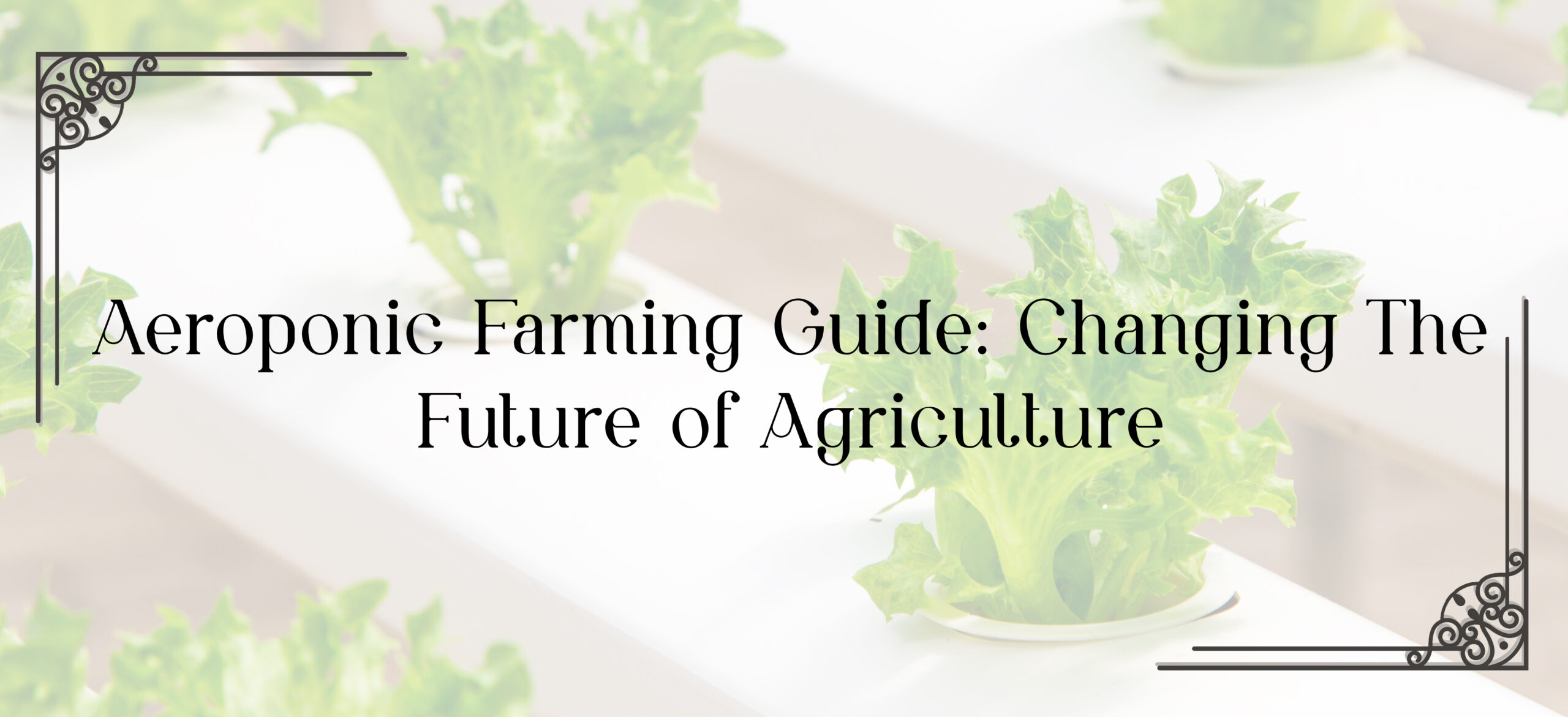Agriculture has been the backbone of human survival, from the time of civilization. Farming techniques have transformed from ancient ways to modern-day innovations. While much around us is changing, one thing has remained constant: our dependence on food. It is the cornerstone of life itself, uniting past and present in a shared human need.
The world is facing some very serious problems: climate change, increased urbanization, and a decrease in arable lands. All these factors make it difficult for our traditional ways of farming to thrive. This situation has opened the door for fresh ideas; urban farming is leading the way. Among the new fascinating developments in this regard is Aeroponic Farming; this is the modern way of growing food, revolutionizing farming practices in case of a world lacking space.
In this article, we’ll explore Aeroponics Farming—a method that promises to redefine farming by harnessing the power of air, technology, and science to nurture the crops of tomorrow.
What is Aeroponics Farming?
The word aeroponics means “working air” and comes from the Greek word for wind, “er” and worker, “ponos.”
Aeroponics Farming is a wonderful way to grow plants without soil. In this system, wind and flooding can deliver nutrients directly to plant roots. As there is no soil, the risk of soil-borne and pest-related diseases reduces. It is a sustainable and environmentally friendly method of growing plants, making it a promising solution for the future of agriculture.
How Does Aeroponics Farming Work?
In Aeroponics Farming, plant roots suspend in the air and periodically dry with a nutrient-rich paste. This mist contains all the essential nutrients and vitamins that plants need for healthy growth. Constant aeration gives the roots plenty of oxygen, which is essential for fast, healthy plant growth.
Comparison with Traditional and Hydroponic Farming
In traditional farming, land can be inconsistent and susceptible to degradation. Another negative is scarce farmland, which makes it less adaptive to modern times.
Hydroponic farming uses water to grow plants but still requires water to grow like a rock animal or clay compost. The roots submerge, so they do not receive nearly as much oxygen, contributing to a generally lower plant and crop yield.
However, in Aeroponics Farming, there is no need for both soil and a growing medium. This creates a cleaner, more controlled environment. The method uses less water and provides better oxygenation to roots, leading to faster growth and higher yields.
Components of an Aeroponics Farming System
Aeroponic Tower
A vertical structure that lets plants grow vertically, maximizing the use of available space, offers adequate amounts of support and nutrition to the plants. Mist nozzles on the towers provide nutritional solutions to the roots. This configuration is perfect for urban farming and small spaces, making it ideal for cities and residences.
Aeroponic Kit
An aeroponic kit has all the necessary tools and equipment to set up an aeroponic system.
Contents are listed below:
- Pump: Moves the nutritional fluid around inside the apparatus.
- Mist nozzles: Spray a fine mist of the nutrition solution.
- Timer: The timer regulates the misting intervals to guarantee that plants are consistently nourished.
- Nutritional Solution: A nutrient solution is a combination of vital minerals and vitamins needed for plant growth.
- Reservoir: Stores the nutrition solution in the reservoir.
- Plant holders: Using screws, firmly anchor the plants inside the tower.
These kits can be useful if you are starting out as a beginner in Aeroponics Farming.
Advantages of Aeroponics Farming
Aeroponics Farming offers several significant advantages over traditional and hydroponic farming methods. It excels in many factors, making it a top-of-the-line solution for growing plants and herbs in an eco-friendly manner.
Faster Plant Growth
In an Aeroponics Farming system, plants grow faster because they receive nutrients and oxygen directly at the roots. This method increases oxygenation, which is important for root health. Roots can absorb nutrients more efficiently, leading to quicker growth and stronger plants. Unlike soil-based systems, where nutrients might not reach the roots uniformly, this method ensures every part of the root system gets all the required nourishment.
Higher Yields
Best for producing higher yields compared to conventional methods. The direct and efficient delivery of nutrients means plants can grow healthier. As a result, it will produce more fruits and vegetables. Each plant receives the optimal amount of nutrients it needs, leading to fast growth and increased productivity. This efficiency results in more crops from the same amount of space. Overall, this maximizes the output and ensures a steady supply of produce.
Water and Nutrient Efficiency
Aeroponics Farming uses significantly less water than traditional farming methods, often up to 90% less. This is because the system recycles the nutrient solution, ensuring minimal wastage. Plants receive the nutrients they need without excess, which means resources are used more effectively. This water and nutrient conservation is cost-effective and earth-friendly, reducing the overall resource footprint of farming.
Space-Saving Benefits
Aeroponic towers are designed for vertical farming, allowing growers to make the most of limited space. This vertical setup is particularly beneficial in urban environments or areas with scarce arable land. By stacking plants vertically, Aeroponics Farming maximizes available space, enabling more plants to be grown in a smaller area. This innovative approach to farming is ideal for cities where space is at a premium. It can help bring fresh produce closer to urban populations.
Applications of Aeroponics Farming
Aeroponics Farming is used in numerous ways and sectors. Nowadays, it is considered one of the best farming alternatives in the market, as it provides exclusive benefits for both the grower and the consumer.
Commercial Agriculture
Aeroponics Farming technology is used in huge farms to enhance crop yields. Using aeroponics minimizes the need for herbicides and pesticides, thus making farming much cleaner and safer. This method helps plants grow under controlled conditions, reducing the danger of pests and diseases.
High yields and rapid growth rates offer substantial advantages for commercial producers. It enhances efficiency and profitability in that regard. Precise fertilizers supplied by aeroponics ensure excellent plant health, producing high crop quality. This procedure also saves water, which is critical for environmentally friendly agriculture.
Urban Farming
Aeroponic towers are ideal for urban farming because they make small plots of land productive. They are placed on top of buildings, terraces, or residential places. This allows city people to grow their own vegetables and produce. There are limited spaces in urban homes, and with vertical growing systems this problems can be easily taken care of.
This approach requires a smaller piece of land than traditional clay gardens; hence, more people can do it. Again, another advantage is that aeroponic-based urban agriculture encourages local food production while reducing the carbon footprint arising from the transportation of food from the countryside.

Space Missions and Research
NASA is investigating the use of flight surveys in long-duration space missions. With no availability of soil in space, it is quite difficult to grow plants. Aeroponics Farming is a solution that allows plants to survive without soil.
This technology allows astronauts to grow fresh herbs and vegetables, assuring a steady supply of nutritious food during long missions. This study aims to develop a sustainable food supply system for future space exploration. Aeroponics Farming could be important in sustaining human life on Mars or other worlds where conventional agricultural methods are ineffective.
Challenges and Solutions
While Aeroponics Farming has many benefits, it also presents some challenges that must be addressed. As we know, everything has its own pros and cons. But, when there is a problem, there must be a solution. Some of them are listed here:
Common Problems
Sometimes pumps that deliver nutrients to the body gets blocked which can lead to many issues. This can occur when the mist nozzles gets blocked by some debris. Nutrient deficiency of the plant is also a popular problem which can occur due to this.
Solutions
Mystery and inspection of the system reduce pump failures and clog up the nozzle. Using quality equipment has a minimal chance of failing. Observing and modifying the nutrient solution makes it possible for plants to get proper nutrition.
Future of Aeroponics Farming
That said, it is clear that with the improvements and advancements, the future of Aeroponics Farming appears bright. For this reason, this technology envisages a new shape, style, and practice of farming that will be healthy to sustain.
Innovations and Technological Advancements
New technologies are now being introduced that are increasing the efficiency and practicality of Aeroponics Farming. Nutrient delivery is now an issue of automation in aeroponic systems. Fertilization and growth rates are regulated through the use of artificial intelligence (AI). This cuts the cost of labor and raises the level of accuracy.
Some of how smart sensors assist in keeping specific growing conditions optimal include the following: These enable Aeroponics Farming to become an option for farming, especially for large-scale production. From the above analysis, it is clear how technology helps provide standard crop production free from tampering by third-party Kenyan parties.
Possible Effects on Annually Produced Food Stocks
Aeroponics Farming could become a revolutionary way of feeding the world’s population. Thus, it offers a viable approach to raising food requirements in society. This method consumes a small amount of water and space and is eco-friendly. From daily aeroponics yield compared to traditional farming systems, it was found that Aeroponics Farming yields are very high. If adopted, it can help fridge food security since more food can be grown in the same space used to produce current yields.
The purpose of this approach and the previous one is to support environmental conservation. The adoption of integrated pest management results in a decrease in pesticide and herbicide use, which subsequently benefits the ecosystems. Thus, Aeroponics Farming can be considered to present how the world can be fed without the negative consequences of the conventional form of farming.
Conclusion
Aeroponics Farming is a game-changer for growing plants. Its sustainable and future-promising features are its backbone. And if it works well for big farms, city gardens, and even space missions. Who knows? What more exciting things do our future behold?
With the right tools and know-how, anyone can start an Aeroponics Farming system at home or in the city. So, I would love to embrace the future of farming with Aeroponics Farming. Enjoy fresh, local produce made by myself at ease in my home. In my eyes, Aeroponics Farming is set to revolutionize how we grow food, meeting global needs in a smart and eco-friendly way.




No responses yet